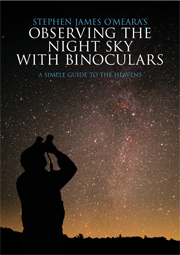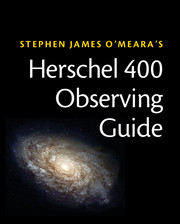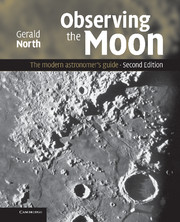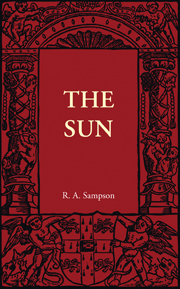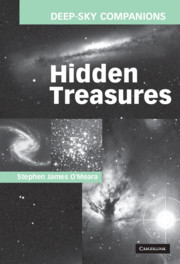Exploring the Solar System with Binoculars
In this journey of discovery, Stephen James O'Meara shows you how to observe our Solar System's wonders with ease, using nothing more than the unaided eye and inexpensive handheld binoculars. The guide presents a new way to identify and appreciate the wonders of the Solar System in detail, such as lunar and solar eclipses, sunspots, the Moon's craters, the planets, meteors, and comets. It is a unique observing guide for all amateur astronomers, proving you don't need big and expensive equipment to enjoy astronomy from your own backyard. You will learn a variety of skills, including how to find Venus in the daytime, how to identify faint features in bright comets, how to increase your chances of seeing an abundant meteor shower, and how to track the changing aspects of the planets and their moons. A must for Solar System explorers everywhere!
<br/><br/><b>Steve O'Meara on exploring the solar system with binoculars - Listen to a Podcast interview by EarthSky:</b>
<object width="272" height="40" data="http://earthsky.org/wp-content/themes/earthsky/swf/player.swf" type="application/x-shockwave-flash"> <param name="allowfullscreen" value="true"> <param name="allowscriptaccess" value="always"> <param name="quality" value="high"> <param name="cachebusting" value="false"> <param name="flashvars" value="flashvars=&duration=90&file=http://earthsky.org/wp-content/uploads/2010/06/100628omeara-CV.mp3&skin=http://earthsky.org/wp-content/themes/earthsky/swf/ES_skin_blue.swf"> </object>
<br/><b>About Steve O'Meara </b><br/>
Stephen James O’Meara, award-winning visual observer, is columnist and contributing editor for Astronomy magazine and former Eye on the Sky columnist for Sky & Telescope. He is the recipient of the prestigious Caroline Herschel Award, the Lone Stargazer Award, as well as the Omega Centauri Award for “his efforts in advancing astronomy through observation, writing, and promotion, and for sharing his love of the sky.” The International Astronomical Union named asteroid 3637
O’Meara in his honor. As the first to sight Halley’s Comet on its return in 1985, his remarkable skills continually reset the standard of quality for other visual observers.
<br>For more exciting titles by O'Meara, please click <a href="http://cambridge.org/us/astronomy/omeara/" target="_blank"><b>here</a>.</br>
- Discover new ways of appreciating the wonders of the Solar System, including the Moon's craters, meteor showers, comets, solar and lunar eclipses, and more
- One of the world's leading visual observers presents a simple methodical approach to help you develop your observational expertise
- Learn how to find Venus in the daytime, how to observe faint features in bright comets, how to maximize your chances of seeing the most meteors during a shower, and much more
Reviews & endorsements
"The six chapters straightforwardly cover the Sun, Moon, Eclipses, planets, comets, and meteors. I was particularly impressed with the chapter on the Moon, which gives photographs at a scale really to look like the binocular Moon, at various stages of illumination, with a key to the formations. The author actually goes into a great deal of detail on his subjects, including both interesting historical sidelights and the very latest information (which is always assiduously attributed – a rarity in a book of this kind). I found very few errors indeed. ... I would recommend this book to all beginning observers. Don’t consider the low page count: this is a large-format book that is excellent value." - Astronomy Now
"While the descriptions and facts should ably answer the many questions of the beginner, the book’s anecdotal passages make this publication shine. The author shares his passion through selections describing his emotions such as 'I saw the spirit of the fireball dancing on its grave' when describing an aerial explosion. The mood is continually heightened such a Tolstoy character who in 'rapture and his eyes wet with tears, contemplated the radiant stare’ for the comet of 1812 or Agesinax's 'all round about environed with fire she is illumined’ to describe the Moon. These historical connections and the many references to ongoing research tells the reader that they share the wonder of the grandeur and complexity of Earth's immediate neighbourhood.
A passion to explore the night sky burns in the hearts of many. Not knowing where to start or how to share this longing is no impediment. With bare eye or inexpensive binoculars, Stephen James O’Meara's book 'Exploring the Solar System with Binoculars' will guide you to satisfy your feelings." - Universe Today
"The naked-eye or binocular observer could hardly hope for a better guide to exploring the Solar System than Stephen J. O'Meara. A skilled visual observer of vast experience and international repute, he is also an engaging and imaginative writer capable of firing the enthusiasm of observers at all levels of ability....thoroughly recommended to those wishing to maximize the potential of naked-eye and binocular observation" -
"Stephen James O’Meara provides an in-depth tour of the Sun, Moon and planets, showing just how much you can do using just the naked eye and binoculars...With plenty of background information on each subject, it is written well with a good pace." - Sky at Night
Product details
April 2010Paperback
9780521741286
166 pages
297 × 211 × 11 mm
0.63kg
200 b/w illus.
Unavailable - out of print July 2019
Table of Contents
- Preface
- 1. The Sun: the angel of light
- 2. The Moon: the lovely dead
- 3. Solar eclipses
- 4. The planets: worlds of wonder
- 5. Comets: divine elegance
- 6. Meteors: when the heavens weep
- Appendices
- Index.


